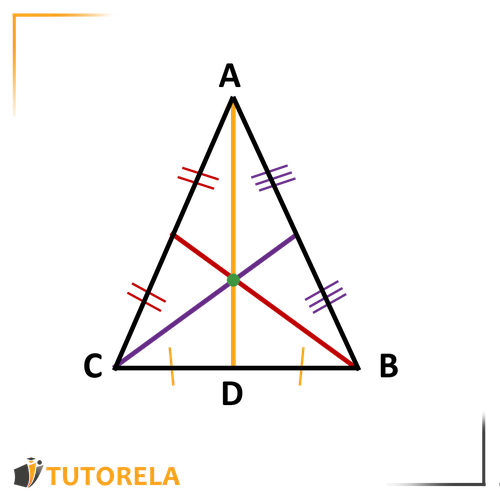A median in a triangle is a line segment that extends from a vertex to the midpoint of the opposite side, dividing it into two equal parts.
Triangle Median Practice Problems and Worksheets
Master triangle medians with step-by-step practice problems. Learn to find medians, calculate areas, and solve centroid problems in triangles.
- Identify and draw all three medians from vertices to opposite side midpoints
- Calculate median lengths in right triangles using the hypotenuse rule
- Find areas of triangles created when medians divide the original triangle
- Solve problems involving medians in equilateral and isosceles triangles
- Locate the centroid where all three medians intersect
- Apply median properties to find missing side lengths and angles
Understanding Parts of a Triangle
Median in a triangle
Additional properties:
- In every triangle, it is possible to draw 3 medians.
- All 3 medians intersect at one point.
- The median to a side in a triangle creates 2 triangles of equal area.
- In an equilateral triangle - the median is also a height and an angle bisector.
- In an isosceles triangle - the median from the vertex angle is also a height and an angle bisector.
- In a right triangle - the median to the hypotenuse equals half the hypotenuse.

Practice Parts of a Triangle
Which of the following is the height in triangle ABC?
Examples with solutions for Parts of a Triangle
Look at the triangle ABC below.
What is the median in the triangle?
A median in a triangle is a line segment connecting a vertex to the midpoint of the opposite side. Here, we need to find such a segment in triangle .
Let's analyze the given conditions:
- : Point is the midpoint of .
- : Point is the midpoint of .
Given that is the midpoint of , if we consider the line segment , it starts from vertex and ends at , passing through the midpoint of (which is ), fulfilling the condition for a median.
Therefore, the line segment is the median from vertex to side .
In summary, the correct answer is the segment .
Answer:
DC
Look at triangle ABC below.
What is the median of the triangle and to which side is it drawn?
A median of a triangle is a line segment that connects a vertex to the midpoint of the opposite side. In triangle , we need to identify such a median from the diagram provided.
Step 1: Observe the diagram to identify the midpoint of each side.
Step 2: It is given that point is located on side . If is the midpoint of , then any line from a vertex to point would be a median.
Step 3: Check line segment . This line runs from vertex to point .
Step 4: Since is labeled as the midpoint of , line is the median of drawn to side .
Therefore, the median of the triangle is for .
Answer:
BE for AC
Given the following triangle:
Write down the height of the triangle ABC.
An altitude in a triangle is the segment that connects the vertex and the opposite side, in such a way that the segment forms a 90-degree angle with the side.
If we look at the image it is clear that the above theorem is true for the line AE. AE not only connects the A vertex with the opposite side. It also crosses BC forming a 90-degree angle. Undoubtedly making AE the altitude.
Answer:
AE
In an isosceles triangle, the angle between ? and ? is the "base angle".
An isosceles triangle is one that has at least two sides of equal length. The angles opposite these two sides are known as the "base angles."
The side that is not equal to the other two is referred to as the "base" of the triangle. Thus, the "base angles" are the angles between each of the sides that are equal in length and the base.
Therefore, when we specify the angle in terms of its location or position, it is the angle between a "side" and the "base." This leads to the conclusion that the angle between the side and the base is the "base angle."
Therefore, the correct choice is Side, base.
Answer:
Side, base.
Look at the two triangles below. Is EC a side of one of the triangles?
Every triangle has 3 sides. First let's go over the triangle on the left side:
Its sides are: AB, BC, and CA.
This means that in this triangle, side EC does not exist.
Let's then look at the triangle on the right side:
Its sides are: ED, EF, and FD.
This means that in this triangle, side EC also does not exist.
Therefore, EC is not a side in either of the triangles.
Answer:
No